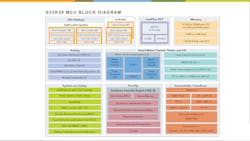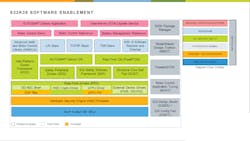Safe MCUs Geared Toward Automotive Applications
This article and video are part of our Electronica 2022 coverage.
NXP has released its S32K39 and S32K37 series of safe microcontroller units (MCUs). They are really system-on-chip (SoC) solutions targeting automotive applications that must meet ASIL D requirements. In the video (above), I talked with Brian Carlson, Director of Global Product and Solutions Marketing at NXP, about safe micros and what's included in the latest chips (Fig. 1).
The S32K39 and S32K37 differ in the latter's lack of the dual motor-control cores. The S32K39 is designed to handle the traction motors found on electric vehicles. It can handle two 200-kHz control loops with 3- and 6-phase motor support. This includes the use of the NanoEdge PWM controller with picosecond resolution. Both platforms are designed to meet ASIL D requirements; the S32K37 can be used in other engine-control-unit (ECU) applications that don't require motor-control support.
Both platforms have a hardware security engine (HSE_B) that has its own Cortex-M0+ in an isolated enclave. They also have their own secure memory and e-fuse support. Among their multiple communication links is Ethernet support for time-sensitive networking (TSN).
The SoCs are supported by lots of software, starting with the Hardware Security Engine firmware that works with a dedicated Cortex-M0+ (Fig. 2). Safe, real-time peripheral drivers, over-the-air (OTA) updates, and multiple RTOS support is in the mix, too.
The chips include a number of redundancies as well as safety and security checking support. On-chip memory includes ECC capability. The lockstep cores typically manage the motor-control support. Included is a safe software resolver that tracks the motor's position using feedback information (Fig. 3). The system can handle control loops at up to 200 kHz, which works well for upcoming silicon-carbide- and gallium-nitride-based (SiC and GaN) power systems.
Thanks to the extensive communication support, multiple S32K3x systems can be employed in a zonal architecture that's typically connected via automotive Ethernet. This provides more system modularity and helps reduce overall system costs.



